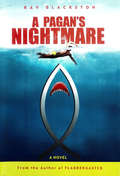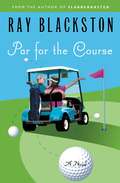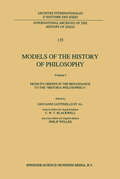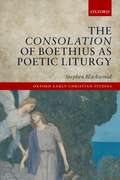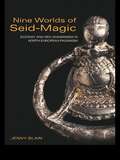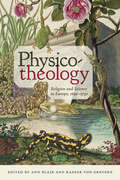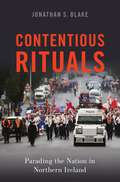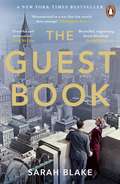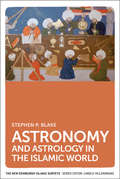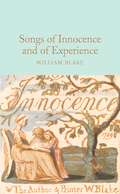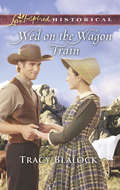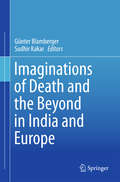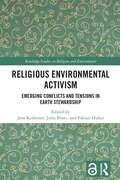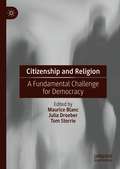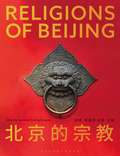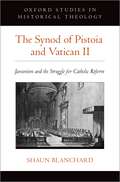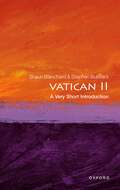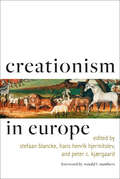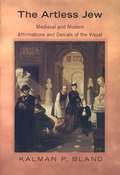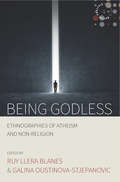- Table View
- List View
A Pagan's Nightmare: A Novel
by Ray BlackstonRay Blackston presents a tongue-in-cheek look at contemporary culture as seen through the eyes of an unwary pagan screenwriter who writes a hit about the last unbeliever on Earth navigating in a thoroughly Christian world.
Par for the Course: A Novel
by Ray BlackstonSparks fly when Ray Blackson returns with his trademark quirky sense of humor. Golf, politics, and romance collide in PAR FOR THE COURSE as golf range owner Chris Hackett meets an attractive political correspondent who turns his world upside down.In PAR FOR THE COURSE, Chris Hackett owns and operates Hack's Golf Learning Center, an eccentric golf range in Charleston, SC. Chris jumps at the chance to step up his game when an attractive new student and political correspondent, Molly, suggests that Chris capitalize on the current, highly polarized, presidential election. This pitting of right versus left means even more income, plus a sharp new girlfriend, and soon Chris, his sidekick, Cack, and their unique golf range are the talk of the town . . . until someone takes the political insults too seriously. Will Molly stick around as Chris learns the true meaning of "playing politics"? And will Chris realize how much he wants her to?
Models of the History of Philosophy: From its Origins in the Renaissance to the ‘Historia Philosophica’ (International Archives of the History of Ideas Archives internationales d'histoire des idées #135)
by C. W. Blackwell Philip WellerModels of the History of Philosophy. From its Origins in the Renaissance to the `Historia philosophica' (a translation of a work published in 1981 in Italian - the bibliography has been updated) gives a comprehensive description of the various forms and approaches in the literature of the history of philosophy from the fifteenth to the middle of the seventeenth century. Several traditions are described, from the well known `prisca theologia' and `perennis philosophia' traditions of Marsilio Ficino and Augustino Steuco, which claimed that the Greeks got their philosophy from the East, to the unknown influence of Scepticism on the history of philosophy by the recovery of Sextus Empiricus, and the German Protestant critical attack on Greek philosophy as Atheistic which was the tradition of the history of philosophy out of which Leibniz developed. Each individual historian of philosophy is given a separate entry which includes a biography, a complete bibliography of his works, a description of his history of philosophy and ends with both an assessment of his reputation during his own time and a complete listing of recent literature on him. As a result the substantial variety in the way the history of philosophy was written and, with it, an overview of the way western civilization developed is described in detail for the first time. For university history of literature, history of culture, history of religion and history of philosophy classes. The book can be used both for undergraduate courses (for specific reading assignments) and as background material for graduate courses. The bibliography provides important aids to many topics which have previously been almost inaccessible.
The Consolation of Boethius as Poetic Liturgy (Oxford Early Christian Studies)
by Stephen BlackwoodThroughout Antiquity and the Middle Ages, literature was read with the ear as much as with the eye: silent reading was the exception; audible reading, the norm. This highly original book shows that Boethius's Consolation of Philosophy - one of the most widely-read texts in Western history-aims to affect the listener through the designs of its rhythmic sound. Stephen Blackwood argues that the Consolation's metres are arranged in patterns that have a therapeutic and liturgical purpose: as a bodily mediation of the text's consolation, these rhythmic patterns enable the listener to discern the eternal in the motion of time. The Consolation of Boethius as Poetic Liturgy vividly explores how in this acoustic encounter with the text philosophy becomes a lived reality, and reading a kind of prayer.
Nine Worlds of Seid-Magic: Ecstasy and Neo-Shamanism in North European Paganism
by Jenny BlainThis accessible study of Northern European shamanistic practice, or seidr, explores the way in which the ancient Norse belief systems evoked in the Icelandic Sagas and Eddas have been rediscovered and reinvented by groups in Europe and North America. The book examines the phenomenon of altered consciousness and the interactions of seid-workers or shamanic practitioners with their spirit worlds. Written by a follower of seidr, it investigates new communities involved in a postmodern quest for spiritual meaning.
Nine Worlds of Seid-Magic: Ecstasy and Neo-Shamanism in North European Paganism
by Jenny BlainThis accessible study of Northern European shamanistic practice, or seidr, explores the way in which the ancient Norse belief systems evoked in the Icelandic Sagas and Eddas have been rediscovered and reinvented by groups in Europe and North America. The book examines the phenomenon of altered consciousness and the interactions of seid-workers or shamanic practitioners with their spirit worlds. Written by a follower of seidr, it investigates new communities involved in a postmodern quest for spiritual meaning.
Physico-theology: Religion and Science in Europe, 1650–1750 (Medicine, Science, and Religion in Historical Context)
by Ann Blair Kaspar Von GreyerzBeginning around 1650, the emergence of a number of new scientific concepts, methods, and instruments challenged existing syntheses of science and religion. Physico-theology, which embraced the values of personal, empirical observation, was an international movement of the early Enlightenment that focused on the new science to make arguments about divine creation and providence. By reconciling the new science with Christianity across many denominations, physico-theology played a crucial role in diffusing new scientific ideas, assumptions, and interest in the study of nature to a broad public. In this book, sixteen leading scholars contribute a rich array of essays on the terms and scope of the movement, its scientific and religious arguments, and its aesthetic sensibilities.Contributors: Ann Blair, Simona Boscani Leoni, John Hedley Brooke, Nicolas Brucker, Katherine Calloway, Kathleen Crowther, Brendan Dooley, Peter Harrison, Barbara Hunfeld, Eric Jorink, Scott Mandelbrote, Brian W. Ogilvie, Martine Pécharman, Jonathan Sheehan, Anne-Charlott Trepp, Rienk Vermij, Kaspar von Greyerz
Contentious Rituals: Parading the Nation in Northern Ireland (Oxford Studies in Culture and Politics)
by Jonathan S. BlakeThroughout the world, divisive monuments, ceremonies, and processions assert and reinforce claims to territory, legitimacy, and dominance. These contested symbols and rituals strengthen and lend meaning to communal boundaries; confer and renew identities; and inflame tensions between groups, polarizing communities and, at times, triggering violence. In Contentious Rituals, Jonathan S. Blake focuses on one such controversial tradition: Protestant parades in the streets of Northern Ireland. Marchers say they are celebrating their culture and commemorating their history, as they have done for two centuries. Catholics see the parades as carnivals of bigotry and strident assertions of power. The result is heightened inter-communal friction and occasional violence. Drawing on over 80 interviews, an original survey, and ethnographic observations, Blake investigates why participants choose to march in parades that are known to be a primary source of sectarian conflict today. His analysis reveals their reasons for acting, the meanings supplied to them, and how they make sense of the contention that surrounds them. Ultimately, he discovers, many paraders are not interested in the politics of their actions at all, but rather in the allure of the action itself: the satisfactions of joining with others to express a collective identity and carry on a cherished tradition. An insightful exploration of the characteristics and dynamics of nationalism in action, Contentious Rituals offers an innovative approach to the contested politics of culture in divided societies and a new explanation for an old source of conflict in Northern Ireland.
Contentious Rituals: Parading the Nation in Northern Ireland (Oxford Studies in Culture and Politics)
by Jonathan S. BlakeThroughout the world, divisive monuments, ceremonies, and processions assert and reinforce claims to territory, legitimacy, and dominance. These contested symbols and rituals strengthen and lend meaning to communal boundaries; confer and renew identities; and inflame tensions between groups, polarizing communities and, at times, triggering violence. In Contentious Rituals, Jonathan S. Blake focuses on one such controversial tradition: Protestant parades in the streets of Northern Ireland. Marchers say they are celebrating their culture and commemorating their history, as they have done for two centuries. Catholics see the parades as carnivals of bigotry and strident assertions of power. The result is heightened inter-communal friction and occasional violence. Drawing on over 80 interviews, an original survey, and ethnographic observations, Blake investigates why participants choose to march in parades that are known to be a primary source of sectarian conflict today. His analysis reveals their reasons for acting, the meanings supplied to them, and how they make sense of the contention that surrounds them. Ultimately, he discovers, many paraders are not interested in the politics of their actions at all, but rather in the allure of the action itself: the satisfactions of joining with others to express a collective identity and carry on a cherished tradition. An insightful exploration of the characteristics and dynamics of nationalism in action, Contentious Rituals offers an innovative approach to the contested politics of culture in divided societies and a new explanation for an old source of conflict in Northern Ireland.
The Guest Book: A Novel
by Sarah BlakeA sweeping, heart-wrenching novel about three generations of a privileged American family, and the secrets that bind them, from the bestselling author of THE POSTMISTRESS - available for preo-rder now "An exploration of memory, identity, love, and family loyalty. Powerful and provocative" Paula McLain, bestselling author of The Paris Wife The Miltons are a powerful old New York family - the kind of family that used to run the world. And in 1935, they still do. Kitty and Ogden Milton seem to have it all: an elegant apartment on the Upper East Side, two beautiful little boys, a love everyone envies. When a tragedy befalls them, Ogden comforts Kitty the only way he knows how - they go sailing, picnic on a small island off the coast of Maine, and buy it. For generations the Miltons of Crockett Island revel in a place that is entirely their own. But it's 1959, and the world is changing: Ogden's firm hire a Jewish man, Len Levy, who earns the admiration of not only his boss, but his boss's beautiful young daughter. When Len and his friend visit the island, the Milton's principles and prejudices are challenged like never before. At the dawn of the 21st century, the family money has run dry, and the island is up for sale. Returning for one last visit, Kitty's granddaughter uncovers disturbing evidence about her family's wealth - and realizes she is on the verge of finally understanding the silences that seemed to hover just below the surface of her family all her life.'I was totally swept away by this beautiful, engrossing, ultimately heartbreaking family saga' Rachel Rhys, author of 'Dangerous Crossing' and 'Fatal Inheritance'
Astronomy and Astrology in the Islamic World (The New Edinburgh Islamic Surveys)
by Stephen P. BlakeIt was the astronomers and mathematicians of the Islamic world who provided the theories and concepts that paved the way from the geocentric theories of Claudius Ptolemy in the second century AD to the heliocentric breakthroughs of Nicholas Copernicus and Johannes Kepler in the sixteenth and seventeenth centuries. Algebra, the Arabic numeral system, and trigonometry: all these and more originated in the Muslim East and undergirded an increasingly accurate and sophisticated understanding of the movements of the Sun, Moon, and planets. This nontechnical overview of the Islamic advances in the heavenly sciences allows the general reader to appreciate (for the first time) the absolutely crucial role that Muslim scientists played in the overall development of astronomy and astrology in the Eurasian world.
Songs of Innocence and of Experience: Shewing The Two Contrary States Of The Human Soul (Macmillan Collector's Library)
by William BlakeWilliam Blake’s Songs of Innocence and of Experience includes some of the visionary poet’s finest and best-loved poems such as ‘The Lamb’, ‘The Chimney-Sweeper’ and ‘The Tiger’. Part of the Macmillan Collector’s Library, a series of stunning, clothbound, pocket-sized classics with gold-foiled edges and ribbon markers. These beautiful books make perfect gifts or a treat for any book lover. This edition has a foreword by Peter Harness. Blake’s work is instantly recognizable by its flamboyance and inventiveness. This gorgeous edition contains stunning reproductions of the fifty-four plates of the poems and illustrations together, which Blake etched himself and coloured by hand. Each has the poem printed on the facing page. Whilst Songs of Innocence captures the innocence of childhood, Songs of Experience is its contrary sequel.
Wed On The Wagon Train: Pony Express Christmas Bride Cowgirl Under The Mistletoe A Family Arrangement Wed On The Wagon Train (Mills And Boon Love Inspired Historical Ser.)
by Tracy BlalockTemporary Marriage
Imaginations of Death and the Beyond in India and Europe
by Günter Blamberger Sudhir KakarThis volume explores current images of afterlife/afterdeath and the presence of the dead in the imaginations of the living in Indian and European traditions. Specifically, it focuses on the deepest and most fundamental uncertainty of human existence---the awareness of human mortality, on which depends any assignment of meaning to earthly existence as also to notions of worldly and otherworldly salvation. This central idea is addressed in the literature, arts, audiovisual media and other cultural artefacts of the two traditions. The chapters are based on two main assumptions: First, that one cannot report on the direct experience of death; so it is only possible to speak allegorically of it. Second, in contemporary Western societies, marked by structural atheism, people look at literature, the arts and mass media to study their depiction and reading of traditionally religious questions of disease, death and the Beyond. This is in contrast to Asian civilizations whose preoccupation with death and Beyond is persistent and perhaps central to the civilizations’ highest thought. The chapters cover a wide spectrum of disciplinary approaches, from psychoanalysis to religious, anthropological, literary and film studies, from sociology and philosophy to art history, and address issues of unsettling power: comforting illusions of afterlife; the relations between afterlife and fertility; visions of technological immortalization of mankind; the problem of thinking about death after the “death of God”; socialist utopias of bodily immortality; fear of Hell and punishment; different concepts in relating the living and the dead; near-death experiences; and cultural practices of spiritualism, occultism and suicide.
Religious Environmental Activism: Emerging Conflicts and Tensions in Earth Stewardship (Routledge Studies in Religion and Environment)
by Julia Blanc Fabian Huber Jens KöhrsenThis volume explores how religious and spiritual actors engage for environmental protection and fight against climate change. Climate change and sustainability are increasingly prominent topics among religious and spiritual groups. Different faith traditions have developed "green" theologies, launched environmental protection projects and issued public statements on climate change. Against this background, academic scholarship has raised optimistic claims about the strong potentials of religions to address environmental challenges. Taking a critical stance with regard to these claims, the chapters in this volume show that religious environmentalism is an embattled terrain. Tensions are an inherent part of religious environmentalism. These do not necessarily manifest themselves in open clashes between different parties but in different actions, views, theologies, ambivalences, misunderstandings, and sometimes mistrust. Keeping below the surface, these tensions can create effective barriers for religious environmentalism. The chapters examine how tensions are manifested and dealt with through a range of empirical case studies in various world regions. Covering different religious and spiritual traditions, they reflect on intradenominational, interdenominational, interreligious, and religious-societal tensions. Thereby, this volume sheds new light on the problems that religions face when they seek to take an active role in today’s societal challenges.
Citizenship and Religion: A Fundamental Challenge for Democracy
by Maurice Blanc Julia Droeber Tom StorrieThis book explores the relationship between religion and citizenship from a culturally diverse group of contributors, in the context of the developing tendency towards fundamentalist and conflicting religious beliefs in European, North African, and Middle Eastern societies. The chapters provide an alternative narrative of the role of religion, presenting diverse ‘lived shades’ of citizenship, as well as accounting for issues of gender equality, minority rights, violence, identity, education, and secularisation. As the renewed role of religious institutions is increasing in Europe and elsewhere, the contributors interrogate the experience of belonging, public policy, welfare services and religious education, highlighting how cooperation between citizenship and religion is necessary in a democratic regime. The research will be of interest to students and scholars across sociology, international relations, and religious studies.
Religions of Beijing
by Bob BlanchardReligions of Beijing offers an intimate portrayal of lived religion in 17 different religious communities in greater Beijing. Students at Minzu University of China spent one year immersed in the routine and practices daily, “writing with” the experiences and perspectives of their practitioners. Each chapter has been translated into English, with students at Drake University (Des Moines, Iowa) facilitating this process. The result is a bi-lingual book (Mandarin, English) that reveals to Chinese- and English-speaking readers the vibrant diversity of lived religion in contemporary Beijing.Each chapter focuses on the histories, practices, spaces, and members of its community, telling the overall story of the renewed flourishing of religion in Beijing. The book is also enriched with over 100 photos that portray this flourishing renewal, capturing the lived experience of ordinary practitioners. Together, the words and photographs of Religions of Beijing draw the reader into the stories and lives of these communities and their members, providing a first-hand look at the contemporary practice of religion in greater Beijing. The religions covered are Buddhism, Daoism, Confucianism, Protestantism, Catholicism, Islam and folk religion.Religions of Beijing is a collaboration of Minzu University of China and Drake University, USA.
Religions of Beijing
by Bob BlanchardReligions of Beijing offers an intimate portrayal of lived religion in 17 different religious communities in greater Beijing. Students at Minzu University of China spent one year immersed in the routine and practices daily, “writing with” the experiences and perspectives of their practitioners. Each chapter has been translated into English, with students at Drake University (Des Moines, Iowa) facilitating this process. The result is a bi-lingual book (Mandarin, English) that reveals to Chinese- and English-speaking readers the vibrant diversity of lived religion in contemporary Beijing.Each chapter focuses on the histories, practices, spaces, and members of its community, telling the overall story of the renewed flourishing of religion in Beijing. The book is also enriched with over 100 photos that portray this flourishing renewal, capturing the lived experience of ordinary practitioners. Together, the words and photographs of Religions of Beijing draw the reader into the stories and lives of these communities and their members, providing a first-hand look at the contemporary practice of religion in greater Beijing. The religions covered are Buddhism, Daoism, Confucianism, Protestantism, Catholicism, Islam and folk religion.Religions of Beijing is a collaboration of Minzu University of China and Drake University, USA.
The Synod of Pistoia and Vatican II: Jansenism and the Struggle for Catholic Reform (Oxford Studies in Historical Theology)
by Shaun BlanchardIn this book, Shaun Blanchard argues that the roots of the Vatican II reforms must be pushed back beyond the widely acknowledged twentieth-century forerunners of the Council, beyond Newman and the Tübingen School in the nineteenth century, to the eighteenth century, when a variety of reform movements attempted ressourcement and aggiornamento. This close study of the Synod of Pistoia (1786) sheds surprising new light on the nature of church reform and the roots of the Second Vatican Council (1962-65). The high-water mark of the late Jansenist reform movement, this Tuscan diocesan synod was harshly condemned by Pope Pius VI in the Bull Auctorem fidei (1794), and in the increasingly ultramontane nineteenth-century Church the late Jansenist movement was totally discredited. Nevertheless, much of the Pistoian agenda--an exaltation of the role of the local bishop, an emphasis on infallibility as a gift to the entire believing community, religious liberty, a more comprehensible liturgy that incorporates the vernacular, and the encouragement of lay Bible reading and Christocentric devotions--would be officially promulgated at Vatican II. Investigating the theological and historical context and nature of the reforms enacted by the Synod of Pistoia, he notes their parallels with the reforms of Vatican II, and argues that these connections are deeper than mere affinity. The tumultuous events surrounding the reception of the Synod explain why these reforms failed at the time. This book also offers a measured theological judgment on whether the Synod of Pistoia was "true or false reform." Although the Pistoians were completely rejected in their own day, the Second Vatican Council struggled with, and ultimately enacted, remarkably similar ideas.
The Synod of Pistoia and Vatican II: Jansenism and the Struggle for Catholic Reform (Oxford Studies in Historical Theology)
by Shaun BlanchardIn this book, Shaun Blanchard argues that the roots of the Vatican II reforms must be pushed back beyond the widely acknowledged twentieth-century forerunners of the Council, beyond Newman and the Tübingen School in the nineteenth century, to the eighteenth century, when a variety of reform movements attempted ressourcement and aggiornamento. This close study of the Synod of Pistoia (1786) sheds surprising new light on the nature of church reform and the roots of the Second Vatican Council (1962-65). The high-water mark of the late Jansenist reform movement, this Tuscan diocesan synod was harshly condemned by Pope Pius VI in the Bull Auctorem fidei (1794), and in the increasingly ultramontane nineteenth-century Church the late Jansenist movement was totally discredited. Nevertheless, much of the Pistoian agenda--an exaltation of the role of the local bishop, an emphasis on infallibility as a gift to the entire believing community, religious liberty, a more comprehensible liturgy that incorporates the vernacular, and the encouragement of lay Bible reading and Christocentric devotions--would be officially promulgated at Vatican II. Investigating the theological and historical context and nature of the reforms enacted by the Synod of Pistoia, he notes their parallels with the reforms of Vatican II, and argues that these connections are deeper than mere affinity. The tumultuous events surrounding the reception of the Synod explain why these reforms failed at the time. This book also offers a measured theological judgment on whether the Synod of Pistoia was "true or false reform." Although the Pistoians were completely rejected in their own day, the Second Vatican Council struggled with, and ultimately enacted, remarkably similar ideas.
Vatican II: A Very Short Introduction (Very Short Introductions)
by Shaun Blanchard Stephen BullivantVery Short Introductions: Brilliant, Sharp, Inspiring The Second Vatican Council (1962-1965), or Vatican II, is arguably the most significant event in the life of the Catholic Church since the Reformation. The Council initiated, intentionally or not, profound changes not simply within Catholic theology, but in the religious, social, and moral lives of the world's billion Catholics. It also reconfigured, intellectually and practically, the Church's engagements with those outside of it - most obviously with regard to other religions. The sixteen documents formally issued by Vatican II constitute some of the most influential writings of the whole twentieth century. Debates over their correct interpretation and authority are constant, but they remain an indispensable point-of-reference for all areas of Catholic life, from liturgy and sacraments, to the Church's vast network of charitable and educational endeavours the world over. In this Very Short Introduction, Shaun Blanchard and Stephen Bullivant present the backstory to this event. Vatican II is explored in light of the wider history of the Catholic Church and placed in the tumultuous context of the 1960s. It distils the research on Vatican II, employing the first-hand accounts of participants and observers, and the official proceedings of the Council to paint a rich picture of one of the most important events of the last century. ABOUT THE SERIES: The Very Short Introductions series from Oxford University Press contains hundreds of titles in almost every subject area. These pocket-sized books are the perfect way to get ahead in a new subject quickly. Our expert authors combine facts, analysis, perspective, new ideas, and enthusiasm to make interesting and challenging topics highly readable.
Creationism in Europe (Medicine, Science, and Religion in Historical Context)
by Stefaan Blancke Hans Henrik Hjermitslev Peter C. KjærgaardFor decades, the creationist movement was primarily situated in the United States. Then, in the 1970s, American creationists found their ideas welcomed abroad, first in Australia and New Zealand, then in Korea, India, South Africa, Brazil, and elsewhere—including Europe, where creationism plays an expanding role in public debates about science policy and school curricula. In this, the first comprehensive history of creationism in Europe, leading historians, philosophers, and scientists narrate the rise of—and response to—scientific creationism, creation science, intelligent design, and organized antievolutionism in countries and religions throughout Europe.Providing a unique map of creationism in Europe, the authors chart the surprising history of creationist activities and strategies there. Over the past forty years, creationism has spread swiftly among European Catholics, Protestants, Jews, Hindus, and Muslims, even as anti-creationists sought to smother its flames. Antievolution messages gained such widespread approval, in fact, that in 2007 the Parliamentary Assembly of the Council of Europe passed a resolution advising member states to "defend and promote scientific knowledge" and "firmly oppose the teaching of creationism as a scientific discipline on an equal footing with the theory of evolution." Creationism in Europe offers a discerning introduction to the cultural history of modern Europe, the variety of worldviews in Europe, and the interplay of science and religion in a global context. It will be of interest to students and scholars in the history and philosophy of science, religious studies, and evolutionary theory, as well as policy makers and educators concerned about the spread of creationism in our time.
Creationism in Europe (Medicine, Science, and Religion in Historical Context)
by Stefaan Blancke Hans Henrik Hjermitslev Peter C. KjærgaardFor decades, the creationist movement was primarily situated in the United States. Then, in the 1970s, American creationists found their ideas welcomed abroad, first in Australia and New Zealand, then in Korea, India, South Africa, Brazil, and elsewhereâ€�including Europe, where creationism plays an expanding role in public debates about science policy and school curricula. In this, the first comprehensive history of creationism in Europe, leading historians, philosophers, and scientists narrate the rise ofâ€�and response toâ€�scientific creationism, creation science, intelligent design, and organized antievolutionism in countries and religions throughout Europe.Providing a unique map of creationism in Europe, the authors chart the surprising history of creationist activities and strategies there. Over the past forty years, creationism has spread swiftly among European Catholics, Protestants, Jews, Hindus, and Muslims, even as anti-creationists sought to smother its flames. Antievolution messages gained such widespread approval, in fact, that in 2007 the Parliamentary Assembly of the Council of Europe passed a resolution advising member states to "defend and promote scientific knowledge" and "firmly oppose the teaching of creationism as a scientific discipline on an equal footing with the theory of evolution." Creationism in Europe offers a discerning introduction to the cultural history of modern Europe, the variety of worldviews in Europe, and the interplay of science and religion in a global context. It will be of interest to students and scholars in the history and philosophy of science, religious studies, and evolutionary theory, as well as policy makers and educators concerned about the spread of creationism in our time.
The Artless Jew: Medieval and Modern Affirmations and Denials of the Visual
by Kalman P. BlandConventional wisdom holds that Judaism is indifferent or even suspiciously hostile to the visual arts due to the Second Commandment's prohibition on creating "graven images," the dictates of monotheism, and historical happenstance. This intellectual history of medieval and modern Jewish attitudes toward art and representation overturns the modern assumption of Jewish iconophobia that denies to Jewish culture a visual dimension. Kalman Bland synthesizes evidence from medieval Jewish philosophy, mysticism, poetry, biblical commentaries, travelogues, and law, concluding that premodern Jewish intellectuals held a positive, liberal understanding of the Second Commandment and did, in fact, articulate a certain Jewish aesthetic. He draws on this insight to consider modern ideas of Jewish art, revealing how they are inextricably linked to diverse notions about modern Jewish identity that are themselves entwined with arguments over Zionism, integration, and anti-Semitism. Through its use of the past to illuminate the present and its analysis of how the present informs our readings of the past, this book establishes a new assessment of Jewish aesthetic theory rooted in historical analysis. Authoritative and original in its identification of authentic Jewish traditions of painting, sculpture, and architecture, this volume will ripple the waters of several disciplines, including Jewish studies, art history, medieval and modern history, and philosophy.
Being Godless: Ethnographies of Atheism and Non-Religion (Studies in Social Analysis #1)
by Roy Llera Blanes Galina Oustinova-StjepanovicDrawing on ethnographic inquiry and the anthropological literature on doubt and atheism, this volume explores people's reluctance to pursue religion. The contributors capture the experiences of godless people and examine their perspectives on the role of religion in their personal and public lives. In doing so, the volume contributes to a critical understanding of the processes of disengagement from religion and reveals the challenges and paradoxes that godless people face.
